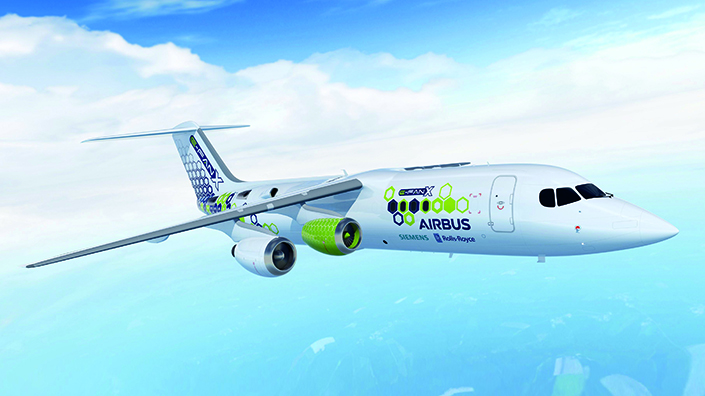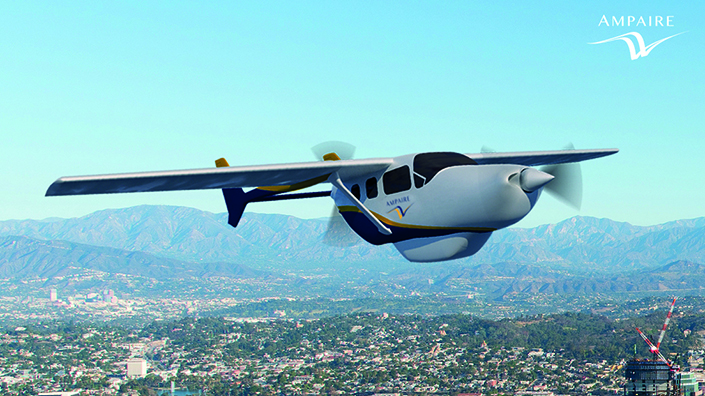In an interview with the BBC, Sir Tim Clark, the president of Emirates, conceded that the aviation industry isn’t doing itself any favours by “chucking billions of tons of carbon into the air. It’s got to be dealt with”.
While some travellers might give in to what the Swedes call flygskam (or “flight shame”) and forego flying altogether, all signs still point to growing demand for air travel in the decades to come.
Figures released in 2018 by the International Air Transport Association, which represents the world’s airlines, revealed that annual passenger numbers could double to 8.2bn by 2037. That’s a figure notably larger than the world’s current living population of 7.7bn.
More than half of new passengers in the next 20 years are predicted to come from the Asia-Pacific region, where the forces of economic growth and larger household incomes are combining to make travel more accessible. Aviation, like many of the world’s carbon-intensive industries, is now facing a dilemma: it must reduce emissions while responding to ever-increasing demand for its services.
Reinventing the plane
Unlike most road vehicles – in which a combustion engine can simply be switched out for a battery – commercial aircraft are not obvious candidates for electrification. This is because, to put it simply, long-range batteries are heavy and planes must be light enough to fly.
Even if developers created batteries that are 30 times more energy dense than those available today, it would still only be possible to fly an Airbus A320 airliner for one fifth of its range with half its payload, according to the company’s chief technology officer, Grazia Vittadini.
However, sceptics should remember that hybrid cars were widely available before their fully-electric counterparts. At the moment, it looks like some areas of commercial aviation could follow a similar trajectory. Industry observers are currently awaiting the arrival of the E-Fan X, one of the world’s first hybrid-electric aircraft demonstrators, which is scheduled to make its first flight in 2021.
A collaborative effort between aerospace titans Airbus, Siemens and Rolls-Royce, one of the test plane’s four jet engines will be replaced by a 2MW electric motor. This electric propulsion unit is powered by an onboard generator and a battery. When significant energy is required, including during take-off, the generation system and the battery will work together to supply it.

From design to prototype
The E-Fan X project is designed to map out and pre-empt the challenges likely to face aviation engineers working with high-power propulsion systems. These include issues with electromagnetic capability, electric thrust management and the altitude and dynamic effects on electric systems. While the E-Fan X is moving rapidly from design to prototype, it still remains more of an experiment than a bona fide emissions solution.
Other aerospace firms have unveiled even bolder visions for the sustainable future of flight. Last summer, Dutch airline KLM announced that it was teaming up with researchers at the Delft University of Technology to create an aircraft concept known as the Flying-V, which promises to be 20% more fuel efficient than the Airbus A350.
The plane’s V-shaped body combines the passenger cabin, fuel hold and wings into a single structure powered by a pair of rear-mounted turbofan engines. This layout is also said to be 15% more aerodynamically efficient than conventional plane designs.
Exciting and novel as new airliner concepts are, environmentalists have rightfully questioned their usefulness in the short-to-medium term. While the global aviation sector has no formal target for eliminating emissions, electric planes probably won’t be rolled out in time to make a serious contribution to decarbonisation. This is why some corners of the industry are placing their bets on cleaner-burning biofuels, which are often blended with petroleum products and used as a drop-in jet fuel substitute.
Sustainable fuel
Shell Aviation – the jet-fuel-producing arm of the global oil major – has notably vowed to provide technical support to Europe’s first sustainable aviation fuel (SAF) plant in the Netherlands. The DSL-01 project, owned by SAF producer SkyNRG, will utilise waste feedstocks, such as used cooking oil, and will be powered by sustainable hydrogen. SkyNRG says it aims for at least 80% CO2 emissions reductions with its products when compared to conventional jet fuel. SAF can also reduce direct emissions of harmful particulate matter by around 90% while eliminating sulphur emissions entirely.
However, concerns about the widespread availability of sustainable feedstocks remain. According to Cait Hewitt, deputy director of the UK’s Aviation Environment Federation, there aren’t likely to be enough available waste products to scale up SAF production for the whole of the global airline fleet.
“Sustainable biofuels, such as those made from household waste, can offer a lifecycle CO2 reduction but are never likely to be available on a large scale given supply-side constraints as well as high cost,” she says. “For longer-haul routes, the only options for genuinely carbon-free aviation currently seem to be using fossil fuels and then balancing the emissions by capturing CO2 from the air and burying it underground, or synthetic liquid e-fuels produced using captured CO2.”
In its landmark report on reducing the UK’s greenhouse gas emissions to net zero by 2050, the Committee on Climate Change, the government’s independent climate advisers, echo Hewitt’s suggestion about sequestering CO2. Emissions could be offset using so-called direct air-capture devices, which essentially suck the carbon out of the atmosphere. The captive greenhouse gas could then theoretically be stored in a subterranean repository. Captured carbon can also be combined with hydrogen – produced using sustainable electricity to power the electrolysis of water – to make what is known as a synthetic electrofuel. However, the committee notes, it will likely be cheaper to store captured carbon than to transform it into a new type of drop-in fuel.
Regardless, both methods still exist in theory rather than in practice. Scientists are confident that these approaches will work, but there are no large-scale underground carbon repositories or electrofuel production plants to rely on today.
Preventing pollution
Aviation’s transition to a low-carbon future has just begun – and it has been painfully slow to take off so far. It was recently revealed that many airlines routinely carry tonnes of extra fuel onboard to avoid paying for it in countries with higher prices. This leads to heavier aircraft and therefore even greater emissions.
This practice, Hewitt argues, must be stopped and common-sense energy-efficiency measures should be taken to prevent excessive pollution. “Maximise the number of passengers per journey,” she urges operators. “First-class seats account for three times more fuel than economy. Also, operate the most efficient aircraft, and don’t carry more fuel than you need just to save money.”
Large emitting industries such as aviation can’t afford to fall victim to techno-utopianism – the belief that advanced technologies will be developed in time to save us from the worst effects of climate change. For too long, regulators and policymakers have neglected to impose enforceable emissions targets on planes and airlines. But, as the world warms and the weather gets weirder, scrutiny is inevitable. It’s up to aviation to rise to the challenge.
Electrifying regional routes

The first hybrid and electric planes to make it off the tarmac en masse are likely to be short-haul models flying regional routes. Several start-ups have launched, or will shortly debut, designs for electrically-powered small planes.
Among these early adopters is Ampaire, the California-based developer of the Electric EEL – a Cessna 337 Skymaster retrofitted with an electric rear motor and a battery in its belly pod. This design is known as a parallel hybrid, meaning that the plane’s twin engines and electric motor work in tandem to optimise power output.
The Electric EEL’s first flight took place on 6 June 2019 above California’s Camarillo airport. The plane, which can carry seven to nine passengers, is the largest hybrid-electric aircraft ever flown. Hawaiian regional carrier Mokulele Airlines has subsequently partnered with Ampaire to conduct regular commercial test flights.
The start-up is also working on a NASA demonstration programme to retrofit the de Havilland Canada DHC-6 Twin Otter, a 19-passenger aircraft, with hybrid technology. According to Cory Combs, Ampaire’s co-founder and chief technology officer, projects like these are all part of the company’s long-term quest to make fully-electric aircraft.
“First we will retrofit second-hand planes, breathing new life into old platforms. Our customers can expect a 50% reduction in fuel costs, and up to 50% reduction in maintenance costs for our hybrid retrofit,” says Combs. “The second phase is working with OEMs to make their aircraft designs hybrid or even fully electric. These two phases will take some time, allowing energy-storage technology to mature, regulations to develop, and infrastructure to be upgraded. It’s then that Ampaire will pursue a clean sheet, fully-electric aircraft design.”
Meanwhile, Israeli start-up Eviation is preparing its own wholly electric aircraft, Alice, for its first flight in early 2020. The plane can carry nine passengers and two crew members and is equipped with three 260kW Siemens electric motors, each of which is fitted with Hartzell variable-pitch propellers, with one on either wing tip and another fitted to the tail. It’s believed that Eviation already had 150 back orders for Alice at the end of 2019.
“Today’s battery-storage solutions are capable of powering flights of 650 miles or less, a distance encompassing half of the world’s 4.5bn flights annually and that range, just as we’ve seen in ground transit, will only continue to increase,” an Eviation spokesperson tells Professional Engineering. “For now, our primary business focus is to impact the immediate market for regional transit. This is a huge addressable market in every country.”
Want the best engineering stories delivered straight to your inbox? The Professional Engineering newsletter gives you vital updates on the most cutting-edge engineering and exciting new job opportunities. To sign up, click here.
Content published by Professional Engineering does not necessarily represent the views of the Institution of Mechanical Engineers.